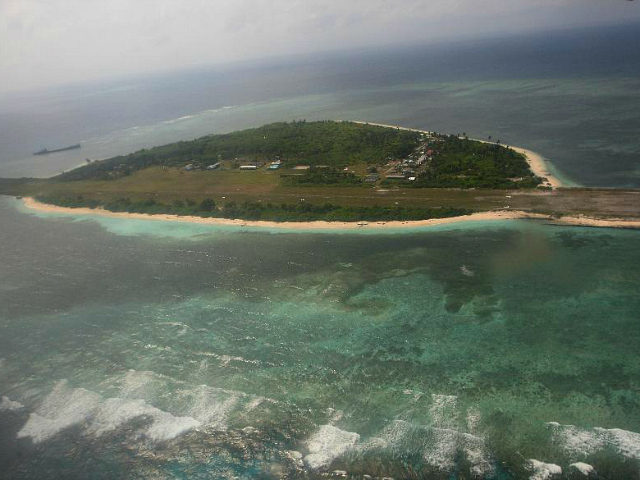China’s Defense Ministry issued an angry rebuke of American coverage of China’s colonization of the South China Sea, particularly waters belonging to the sovereign territory of other nations. Ministry spokesman Senior Col. Wu Qian insisted on Thursday that American media are “ignoring the positive efforts” China has made in the region.
China claims almost the entire South China Sea, including parts of the sovereign territory of Vietnam, the Philippines, Brunei, Taiwan, and Malaysia. The Permanent Court of Arbitration at the Hague ruled in 2016 that China’s claims in the regions were illegitimate and its construction in that region illegal.
China has, nonetheless, continued to build artificial islands on reefs in the Spratly and Paracel island chains, belonging to Vietnam and the Philippines. The People’s Liberation Army (PLA) has equipped these artificial islands with advanced military surveillance equipment, fighter jets, and is preparing to build “floating nuclear power stations,” according to a recent Pentagon report.
“It is a fact that the islands in the South China Sea have been the Chinese territory ever since the ancient times,” Wu told reporters at a regular press briefing Thursday. “It is also a fact that freedom of navigation in the region has never been a problem. For a period of time, the US side has been hyping up the South China Sea issue, attempting to blame China for harming freedom of navigation in the region.”
Wu insisted that “a lie will always remain a lie although it has been told a thousand times,” referring to repeated reports showing Chinese military activity in the region. Wu denied that any military construction had occurred, instead claiming, “The island construction by China is mainly for civilian purposes. It is reasonable and legitimate.” Wu added that only “necessary defense facilities” exist on the island.
“I noticed that the US side has been ignoring the positive efforts China has made to maintain peace and stability in the South China Sea,” Wu continued. “For example, recently, we released a piece of news about China’s sending a professional search and rescue ship named as South China Sea Rescue-115 to the Nansha [Spratly] Islands. However, I did not find any media coverage from the US media.”
“I would like to remind the US side not to purposefully turn a blind eye to China’s efforts. China will, as always, make positive efforts to maintain peace and stability in the South China Sea,” Wu concluded.
Chinese officials have repeatedly insisted the purpose of its construction in the region is mainly to aid search and rescue operations, claiming that such development is necessary in light of the still-unresolved 2014 disappearance of Malaysia Airlines Flight 370. On Friday, the PLA had the opportunity to test its rescue equipment, responding to requests from the Philippines to aid a Philippine Navy ship that stranded itself in disputed territory. According to the South China Morning Post, Chinese coast guard vessels rapidly arrived at the Spratly Islands’ Half Moon Shoal, where the BRP Gregorio del Pilar was stuck and is amicably discussing how to help the rescue with Manila.
Tensions between Manila and Beijing have accelerated recently following the warning Philippine President Rodrigo Duterte issued to China to “temper its behavior” in Philippine territory this month. Duterte has actively resisted challenging China in the region, expressing on multiple occasions a fear that the Philippine military is not sufficiently equipped to confront the massive PLA. His friendly stance toward Beijing contradicts the majority attitude of his constituents, however, according to recent polls, triggering a slight change in attitude from the head of state.
The Chinese Foreign Ministry responded by dismissing Duterte’s claims in the Spratly Islands entirely. “China urges the relevant party to meet China halfway, and jointly protect the present good situation that has not come easily in the South China Sea,” a Ministry statement read.
The United States has escalated its activities in the sea in response to China’s growing presence there. Under President Donald Trump, the U.S. Navy has increased its number of Freedom of Navigation Exercises (FONOPs) in which ships travel through the international waters in the South China Sea to assert that ships of any nationality can do so without needing permission from China or any other country. Reports this week suggested that, in addition to that activity, “several U.S. Air Force B-52H Stratofortress heavy long-range bombers have flown through the contested East and South China Seas multiple times this month.”
U.S. Maj. John Radtke, 96th EBS mission planner, told reporters the flights raised their “readiness to serve as a credible deterrent force and presence within the theatre.”
The new activity follows warnings from the Pentagon that the U.S. military will indeed increase its presence in the region in response to the threat that China poses its neighbors.
“I think what you’ll see is certainly a continuation of freedom of navigation. I think you’ll see perhaps more countries joining in presence activities — which if not a 12-nautical mile challenge presence in the South China Sea — is important because China claims the whole thing through the 9-dash line,” Assistant Secretary of Defense for Asian and Pacific Security Affairs Randall Schriver told reporters at a recent think-tank event.

COMMENTS
Please let us know if you're having issues with commenting.